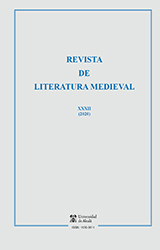Textual transmission and catalogue of poetic work of Pedro de Gracia Dei
DOI:
https://doi.org/10.37536/RLM.2020.32.0.79745Keywords:
Pedro de Gracia Dei, Cancionero poetry, Codicology, Textual transmission, CatalogueAbstract
The textual transmission of the work in verse by Pedro de Gracia Dei extends over four centuries and is characterized, fundamentally, by the abundant diffusion through copies manuscripts. His poetic production shows an important thematic heterogeneity, since the texts are inserted in lines as different as heraldry, historiography or eulogies to Isabel la Católica. This work establishes a study and delimitation of Pedro de Gracia Dei's poetic corpus from the testimonies in which each of the compositions is transmitted, with the aim of solving the problems that affect the titles, content and metric structure of the poems.
Downloads
Métricas alternativas
References
DUTTON, Brian (1990-1991), El Cancionero del siglo XV (c. 1360-1520). Salamanca: Universidad de Salamanca, 7 vols.
GAYANGOS, Pascual de (1882), Pedro de Gracia Dei, Blasón General y Nobleza del Universo. Madrid: Imprenta M. Murillo [ed. facsímil de la ed. Coria, 1489].
GÓMEZ SIERRA, Esther (ed.) (2000), Diálogo entre el prudente rey y el sabio aldeano (olim Libro de los pensamientos variables). London: Departament of Hispanic Studies/Queen Mary and Westfield College.
INFANTES, Víctor (1995), «La Cortesía en verso de Pedro de Gracia Dei y su tratado La Criança y virtuosa doctrina (1488)», en Rose Duroux (ed.), Traités de savoir-vivre en Espagne et au Portugal du Moyen Âge à nos jours. Clermont Ferrand: Association des Publications de la Faculté des Lettres et Sciences Humanines de Clermont Ferrand, pp. 43-54.
JARDIN, Jean Pierre (2016), «Pedro de Gracia Dei, roi d’armes et poète. Entre historie, littérature et arts graphiques», e-Spania, 23 (2016). En línea. DOI: <https://doi.org/10.4000/e-spania.25239> [consulta: 21/01/2020].
LÓPEZ ESTRADA, Francisco (1988), «Anuncios renacentistas en el Libro de los pensamientos variables», en VV.AA., Homenaje a Eugenio Asensio. Madrid: Gredos, pp. 277-289
MANGAS NAVARRO, Natalia A. (2019), «Una fuente de poesía de cancionero: estudio codicológico de MN57», en Josep Lluís Martos y Natalia A. Mangas (eds.), Pragmática y metodologías para el estudio de la poesía medieval: Alacant, Publicacions de la Universitat d’Alacant, pp. 151-165.
MANGAS NAVARRO, Natalia A. (2020), «Nuevas fuentes para la poesía de Pedro de Gracia Dei», Revista de Cancioneros impresos y manuscritos, 9, pp. 44-75.
MARTÍNEZ ALCORLO, Ruth (2016), La literatura en torno a la primogénita de los Reyes Católicos: Isabel de Castilla y Aragón, princesa y reina de Portugal (1470-1498) [Tesis Doctoral]. Madrid: Universidad de Complutense de Madrid.
PAZ Y MÉLIA, Antonio (ed.) (1892), Opúsculos literarios de los siglos XIV a XVI. Madrid: Sociedad de Bibliófilos Españoles.
PEREA RODRÍGUEZ, Óscar (2002), «La utopía política en la literatura castellana del siglo XV: el Libro de los pensamientos variables (BNM, ms. 6642)», eHumanista: Journal of Iberian Studies, 2, pp. 23-62.
PEREA RODRÍGUEZ, Óscar (2007), «Alta reina esclareçida: un cancionero ficticio para Isabel la Católica», en Luis Antonio Ribot García, Julio Valdeón Baruque y Elena Maza Zorrilla (coords.), Isabel la Católica y su época: actas del Congreso Internacional. Valladolid-Barcelona-Granada, 15 a 20 de noviembre de 2004. Valladolid: Instituto Universitario de Historia Simancas, pp. 1355-1383.
TORO PASCUA, María Isabel (2005), «Nuevos y viejos poemas para el “Cancionero del siglo XV (c. 1360-1520)”. Fuentes manuscritas», en Javier San José Lera (coord.), Praestans labore Victor: homenaje al profesor Víctor García de la Concha. Salamanca: Ediciones de la Universidad de Salamanca, pp. 73-92.
Downloads
Published
How to Cite
Issue
Section
License
The opinions and facts stated in each article are the exclusive responsability of the authors. The University of Alcalá is not responsible in any case for the credibility and aunthenticity of the studies.
Authors will retain the rights on their work, even if they will be granting the journal a non-exclusive right of use to reproduce, edit, distribute, publicly communicate and show their work. Therefore, authors are free to enter into additional, independent contracts for non-exclusive distribution of the works published in this journal (such as uploading them to an institutional repository or publishing them in a book), as long as the fact that the manuscripts were first published in this journal is acknowledged.
Works are published under the terms stipulated in the Attribution-NonCommercial-ShareAlike 4.0 International License (CC BY-NC-SA 4.0) that allows third parties to share the work under the following conditions:
Attribution — You must give appropriate credit, provide a link to the license, and indicate if changes were made. You may do so in any reasonable manner, but not in any way that suggests the licensor endorses you or your use.
NonCommercial — You may not use the material for commercial purposes.
ShareAlike — If you remix, transform, or build upon the material, you must distribute your contributions under the same license as the original.









